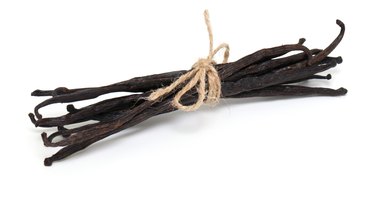
Pastry making was a very different proposition just a few centuries ago. Sugar was known, but rare until European planters built their great estates in the Caribbean and South America. Heavy cream for whipping came in the late 19th century, with milk-separating machines. Even chocolate and vanilla, those two staples of the pastry chef's art, were New World plants that came into their own in the 18th century.
Vanilla
Video of the Day
Vanilla beans are the seed pods of an orchid native to Mexico and Central America. The seed pods are gathered up when mature and exposed to the heat of the tropical sun, or sometimes steamed in modern production. This damages the pods' cell walls, and the resulting chemical reactions brown the pods and create the signature vanilla flavor. Natural vanilla is one of the most complex flavors occurring in nature, with over 200 different volatile compounds in the processed beans.
Video of the Day
Using Vanilla
The beans themselves are very fragrant, but inconvenient to incorporate into a dish because of their leathery texture. Ordinarily, you'll cut the bean open lengthwise, and scrape out the sticky seeds. These and the pod go into the recipe's liquid ingredient, usually milk or cream, and you steep them for 10 or 15 minutes to extract the flavor. Then you remove the pod and use the milk. The rinsed pods retain some flavor, and if you keep a few in a jar with some sugar, the sugar will take on the vanilla flavor as well.
Vanilla Extract
The process of using whole beans is rather cumbersome, and there was an obvious niche for a product that would streamline vanilla use. This product is vanilla extract, which was first made by steeping vanilla beans in alcohol for a period of months. The alcohol absorbs vanilla's flavor and brown color, and transfers the flavor readily to foods. Artificial extracts are made by synthesizing vanillin, the main flavor compound of the 200 found in the beans. It is normally made brown with caramel coloring, to resemble natural vanilla extract, but a clear version is available for commercial bakers.
Using Vanilla Extract
Vanilla extract is alcohol-based, meaning it evaporates readily at temperatures near the boiling point of water. Older recipes that add vanilla to heated ingredients were usually intended for vanilla beans. In most cases vanilla extract is added to the recipe late, to minimize evaporation. Natural vanilla extract has the finest flavor, and is often added to whipped cream or icing. Artificial vanilla extract is less appealing, but is also slower to evaporate and can impart a stronger flavor to baked goods. Clear vanilla is best for preserving pristine colors in icing, glazes or white cakes, such as angel food cake.